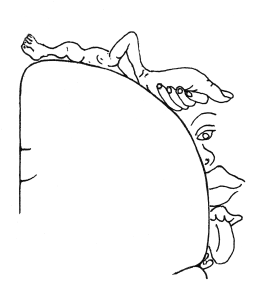
Map depicting the portion of the sensory cortex devoted to different body parts
When looking for body language clues, the hands are an often overlooked region. This is rather unfortunate because, relative to their size, the hands occupy a disproportionately large region of the motor and sensory cortices of the brain (Sherwood 148-150). What does that mean exactly? It suggests that the hands are both very sensitive and very good at making finely controlled movements. Likewise, the hands are also very adept at expressing our inner emotional states.
The most confident position for the hands is referred to as steepling. To make this gesture, place the tips of your fingers against the corresponding fingers of the other hand. The palms of your hands should be apart and the fingers spread apart. People sometimes separate and rejoin their fingers to the rhythm of their speech to help drive home their point.
Although the photo to the left depicts the most prominent display of steepling, there are some notable variations. Some people will have just their pointer finger and thumb pointing out, with the rest of their fingers interlaced. Not everyone steeples in front of their chest either. Some people prefer to steeple under their desk, in their lap, or at their waist.
Low confidence displays of the hands involve finger interlacing. If during the course of a conversation a person switches from steepling to interlaced fingers, you should take note–whatever that person just thought, said or heard made them lose a bit of confidence. The reverse is true for a person who changes from interlaced fingers to a steeple display (Navarro 147-150; Nierenberg 94).
When someone has interlaced their fingers, the tightness with which they press their fingers together is related to how anxious they are feeling. This is an example of a pacifying behavior (Navarro 35). People who are feeling more insecure will press their fingers tighter than those who are less anxious. Although steepling and finger interlacing are often performed subconsciously, these are certainly gestures that you can consciously choose to display in social or business encounters. Steepling at appropriate times will not only make others perceive you as more confident, but it will also make you feel more confident in what you are saying or doing.
References
- Navarro, Joe, and Marvin Karlins. What Every BODY Is Saying: An Ex-FBI Agent’s Guide to Speed-reading People. New York, NY: Collins Living, 2008. Print.
- Nierenberg, Gerard I., and Henry H. Calero. How to Read a Person like a Book. New York: Hawthorn, 1971. Print.
- Sherwood, Lauralee. Human Physiology: From Cells to Systems. Belmont, CA: Brooks/Cole, Cengage Learning, 2013. Print.

